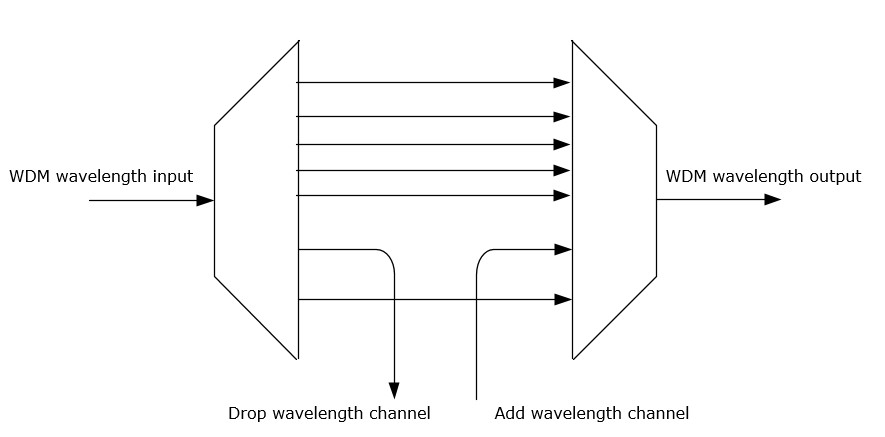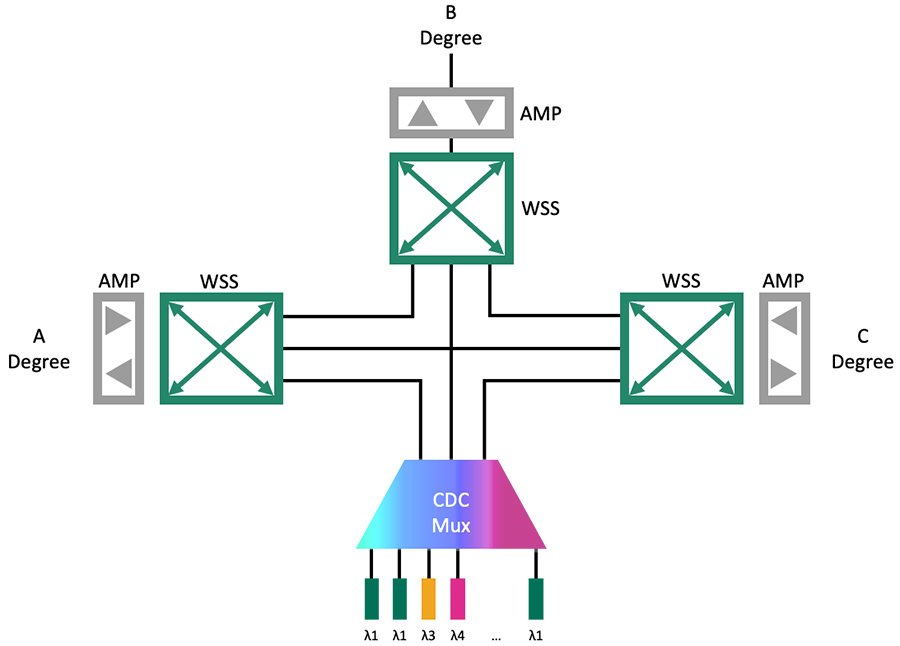OADM (Optical Add-Drop Multiplexer) overview
With the increasing shortage of fiber optic cable resources in urban areas, to make better use of the current optical fiber facilities and increase the network's coverage area, a device that can download and upload optical signals of specific bands from the trunk optical cable is required. To meet this requirement, optical add-drop multiplexers (OADMs) have been introduced in metro/access networks to selectively download and upload specific optical channels through filters. OADM is a low-cost pure passive device with high reliability, strong scalability and low loss, so it is widely used. This article will explain all the knowledge of OADM. Let’s dive right in.
What is the function of OADM?
The OADM has three functions: the optical multiplexer can multiplex the uploaded signal into the optical fiber trunk, and the optical demultiplexer drops the signal of the optical trunk, so that other bands can pass through the OADM without being affected. Multiplexers are used to couple two or more wavelengths into the same fiber. Reconfiguration can then be accomplished through fiber patch panels or optical switches that direct wavelengths to optical multiplexers or drop ports. A demultiplexer separates multiple wavelengths in an optical fiber and directs them to multiple optical fibers.

What is the types of OADM?
OADM is divided into FOADM (Fixed Optical Add/Drop Multiplexer) and ROADM (Reconfigurable Optical Add/Drop Multiplexer) in terms of wavelength scheduling function. In FOADM, the add/drop wavelength is already selected and cannot be configured remotely until human intervention changes it. In ROADM, wavelengths between optical demultiplexers/multiplexers can be dynamically directed from the output of the demultiplexer to any input of the multiplexer, enabling remote configuration of wavelength scheduling. That is, you can use software to ensure which bands transmit in which directions.
FOADM network
FOADM is mainly composed of filters, and its function is to add or retrieve certain wavelengths of light fixedly. The common FOADM can be divided into three types, namely thin film filter type (TFF type), fiber Bragg grating (FBG type) and integrated planar arrayed waveguide grating (AWG type). From the frequency band, FOADM can be divided into DWDM OADM and CWDM OADM.
ROADM network
ROADM can adjust the upper and lower wavelengths with the distribution network at any time, so as to reconstruct the network resource allocation and flexibly meet the requirements of modern urban networks. Therefore, ROADM has flexible characteristics, coupled with the substantial advantages of optical switches, making it the fastest growing ROADM based voa attenuator. based ROADM (switch based OADM). ROADM is mainly composed of wavelength selective switch (WSS), multiplexers and demultiplexers. Switch-based OADMs are mainly divided into wavelength-independent switch arrays and wavelength-selective switches.
ROADM has developed to the present, and the more high-end one is CDC-ROADM. Namely colorless, directionless and contentionless (CDC) ROADMs. The revolutionary advantage of CDC-ROADM is that it can upload and download any band on any port, and at the same time solve the problem that the same band cannot be placed on the same path, which greatly reduces the difficulty of fault recovery Efficiency is also improved.

However, regardless of the type of OADM structure, the basic requirements for the product are the same. The insertion loss is as low as possible, the isolation between channels is high to avoid affecting other bands, and it is not sensitive to changes in ambient temperature. In addition, the OADM should ensure that the power transmitted between the channels is basically the same in the process of adding and dropping channels. The equipment needs to be applied on a large scale. In terms of implementation, the installation and operation of the OADM should be simple, convenient, and cost-effective.
Application of OADM
In 2022, the main field of OADM application is the metropolitan area network, which can give full play to its networking flexibility, facilitate network upgrade and expansion, and is an ideal multi-service transmission platform for metropolitan area network applications. OADM can support eth, SDH, FC, and other services, which greatly increases its flexibility. OADM is generally used in conjunction with OXC. Optical cross-connect (OXC) equipment allows the dynamic combination of different networks and allocates wavelength resources as needed to achieve wider network interconnection. This combination greatly improves the efficiency of processing information, and it overcomes the limitation that information can only be up and down on nodes in traditional networks. Between two optical cross-connect nodes or optical switching nodes, the optical path can be up and down at any time as required.

Summary
There is a lot more to know about OADM. If you want to know how to choose suitable OADMs, please bookmark QSFPTEK.com, we will bring you more valuable content in the future. At the same time, QSFPTEK also provides FOADM equipment and DWDM SFP+/SFP28/QSFP28 for your purchase, please contact us if you are interested.










